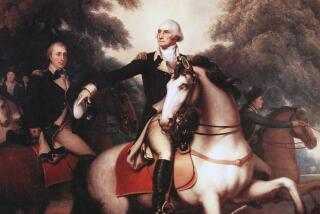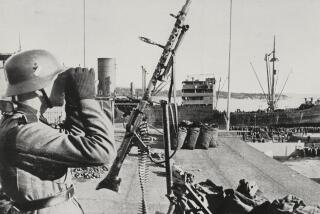Eisenhower had a second, secret D-day message

Gen. Dwight D. Eisenhower issues a message for soldiers, sailors and airmen prior to the D-day invasion.
Gen. Dwight D. Eisenhower was anxious and restless the night of June 5, 1944. He’d been working 20-hour days at his headquarters at Southwick House outside Portsmouth, England, planning the D-day invasion. The assault had already been postponed once by foul weather.
Eisenhower wasn’t sleeping well. He was drinking far too much coffee. He was smoking up to four packs a day of unfiltered Camels, according to Keith Huxen, senior director of research and history at the National WWII Museum in New Orleans.
And now Allied troops were launching. There was no turning back.
“Up to that point he was basically the most powerful man in the world -- and then it’s out of his hands,” Huxen said. “There’s nothing he can do except hope the machinery he built works.”
In his private quarters inside a trailer on the Southwick grounds, Eisenhower wrote an Order of the Day to his troops. The first draft was typed. Eisenhower edited it in pencil.
The original draft, and the thoughtful edits, reflects the extraordinary demands placed upon the Allied force assembled for Operation Overlord, which occurred 70 years ago Friday.
Eisenhower had originally written two sentences toward the bottom: “The eyes of the world are upon you. The hopes and prayers of liberty-loving people everywhere go with you.”
Eisenhower circled the sentences and moved them to the top of the message. He also changed the word “go” to the more muscular “march.”
A sentence about the enemy -- “You may expect him to fight savagely” -- was changed to the more emphatic “He will fight savagely.”
And in his closing remarks, Eisenhower crossed out his original “We can and we will win.” In pencil, he substituted: “We accept nothing less than full victory!” adding an exclamation point.
He recorded the message, which was broadcast over radio to the troops the next day.
But the mission weighed so heavily on Eisenhower that he wrote a second message that night in pencil on a 4 1/2-by-7-inch sheet of notebook paper.
It came to be known as the “In Case of Failure Letter.” The supreme Allied commander intended it for his troops if the invasion failed. In four sentences, he accepted the blame:
“Our landings in the Cherbourg-Havre area have failed to gain a satisfactory foothold and I have withdrawn the troops. My decision to attack at this time and place was based upon the best information available. The troops, the air and the Navy did all that Bravery and devotion to duty could do. If any blame or fault attaches to the attempt it is mine alone.”
The second sentence originally began “This particular operation,” but Eisenhower switched it to the more personal “My decision to attack.”
He tucked the note into his wallet.
“Eisenhower knew some of those men were not coming back, no matter what happened,” Huxen said. “But he had to do it. That’s an awful lot on any individual’s mind.”
Eisenhour was so anxious that he mistakenly dated the note July 5, instead of the actual date, June 5.
More than a month later, on July 11, with Allied forces in full control of the Normandy coast and pushing into France, Eisenhower came across the note in his wallet. He showed it to his naval aide, Capt. Harry C. Butcher.
Butcher asked to keep the note. Reluctantly, Eisenhower gave it to him. Today it is safeguarded in a security vault at the Dwight D. Eisenhower presidential library and museum in Abilene, Kan.
The note reflected Eisenhower’s character, Huxen said. “It shows a greatness of spirit that’s rare in leaders.”
More to Read
Start your day right
Sign up for Essential California for news, features and recommendations from the L.A. Times and beyond in your inbox six days a week.
You may occasionally receive promotional content from the Los Angeles Times.






